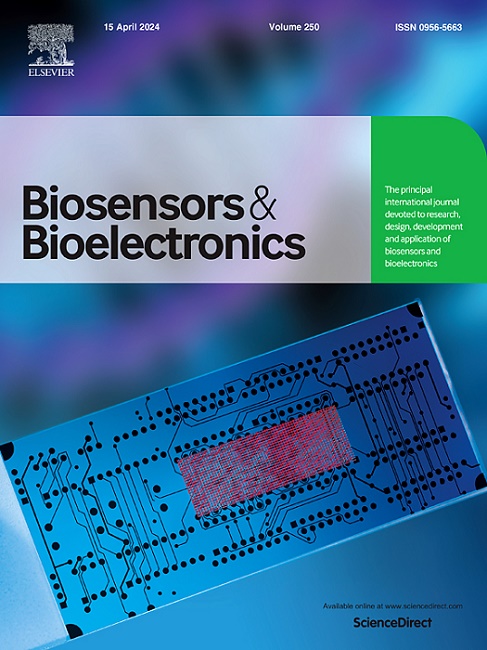Intramicellar sensor assays: Improving sensing sensitivity of sensor array for thiol biomarkers
IF 10.5
1区 生物学
Q1 BIOPHYSICS
引用次数: 0
Abstract
Array-based analysis allows for precise disease diagnosis by simultaneously detecting multiple biomarkers. However, most array sensing platforms rely on non-covalent interactions between sensors and analytes, which limits their sensitivity. This study enhances the sensitivity of array analysis for thiol biomarkers by incorporating polyion complex micelles into the sensor array design. Polyion complex micelles are formed through the self-assembly of carbon dots (CDs) and anionic diblock copolymers. The sensing detection process can occur inside the core of the micelle, the confined space and ionic environment within the core reduce the interaction distance between CDs, metal ions, and analytes, thereby significantly improving detection sensitivity while minimizing metal ions consumption. The developed array system can accurately identify multiple thiols across a broad concentration range (0.5–1000 μM) with 100% accuracy. Additionally, support vector machine (SVM) analysis reveals a detection limit of approximately 0.1 μM for individual thiol systems. Compared to non-micellar approaches, this micelle-based array reduces the detection limit for thiol biomarkers by 20-fold and decreases Ag+ usage by 40-fold. The system is suitable for both qualitative and quantitative analysis of thiol biomarkers, offering a powerful tool for the accurate diagnosis of thiol-related diseases.

膜内传感器测定:提高传感器阵列对硫醇生物标志物的传感灵敏度。
基于阵列的分析允许通过同时检测多种生物标志物来精确诊断疾病。然而,大多数阵列传感平台依赖于传感器和分析物之间的非共价相互作用,这限制了它们的灵敏度。本研究通过在传感器阵列设计中加入多离子络合物胶束,提高了巯基生物标志物阵列分析的灵敏度。通过碳点(CDs)和阴离子二嵌段共聚物的自组装形成多离子络合物胶束。传感检测过程可以在胶束核心内进行,核心内的密闭空间和离子环境减少了CDs、金属离子和被分析物之间的相互作用距离,从而显著提高了检测灵敏度,同时最大限度地减少了金属离子的消耗。所开发的阵列系统可以在宽浓度范围(0.5-1000 μM)内准确识别多种硫醇,准确度为100%。此外,支持向量机(SVM)分析显示,单个硫醇体系的检测限约为0.1 μM。与非胶束方法相比,这种基于胶束的阵列将硫醇生物标志物的检测限降低了20倍,将Ag+的使用降低了40倍。该系统适用于硫醇生物标志物的定性和定量分析,为准确诊断硫醇相关疾病提供了有力的工具。
本文章由计算机程序翻译,如有差异,请以英文原文为准。
求助全文
约1分钟内获得全文
求助全文
来源期刊

Biosensors and Bioelectronics
工程技术-电化学
CiteScore
20.80
自引率
7.10%
发文量
1006
审稿时长
29 days
期刊介绍:
Biosensors & Bioelectronics, along with its open access companion journal Biosensors & Bioelectronics: X, is the leading international publication in the field of biosensors and bioelectronics. It covers research, design, development, and application of biosensors, which are analytical devices incorporating biological materials with physicochemical transducers. These devices, including sensors, DNA chips, electronic noses, and lab-on-a-chip, produce digital signals proportional to specific analytes. Examples include immunosensors and enzyme-based biosensors, applied in various fields such as medicine, environmental monitoring, and food industry. The journal also focuses on molecular and supramolecular structures for enhancing device performance.
文献相关原料
公司名称
产品信息
阿拉丁
Potassium 1,3-dioxoisoindolin-2-ide
阿拉丁
Toluenesulfonyl chloride
阿拉丁
Poly(ethylene glycol methyl ether) (PEG113-OH)
 求助内容:
求助内容: 应助结果提醒方式:
应助结果提醒方式:


